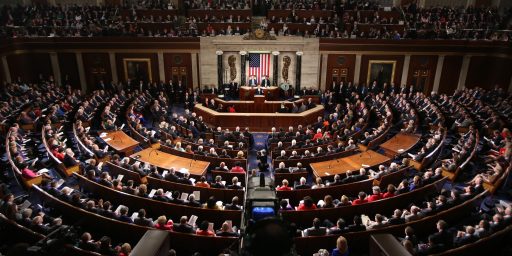An Example of the Reporting Problem in American Politics

This morning while making my coffee I was listening to NPR and heard Dominico Montanaro give a politics run-down about the Mar-a-Lago documents which concluded in a brief discussion of the upcoming elections. There is no transcript at the moment (maybe they will post one later, as I seem to recall to be the process at NPR), but the entire 5ish minute segment can be found here (the relevant part start at ~3:50).
What struck me about the report is that Montanaro, who is a solid reporter, describes the US Congressional races in the typical narrative of American political reporting: as if it is a fair horserace wherein the outcomes actually reflect national sentiment, instead of a system of seats that are largely pre-determined by geographical factors (both via artifice, i.e., districting, or happenstance, i.e., state borders).
For example, while he does note that the House has a very limited number of competitive seats (roughly 7%) that are actually competitive he embeds it in the broader horserace narrative and even implies that this has changed recently. Indeed, he noted that “a few months ago” he would have seen a potential “red wave” while now the Rs are favored to take the House by only narrow margins.
Now, that fits the narrative that we have been hearing in the mainstream press (and fits the constant way elections are covered in the US). But let’s remember that first, the likelihood of the out-of-power party taking back the House in a president’s first midterm has been high for reasons that I have written about before (and this has been a known likelihood since before Biden was sworn in). Perhaps more important, however, we have known since at least April that the margins of victory would likely be more narrow than some Ds feared.
Let me refer you to my April 9, 2022 post: A “Fairer” Map for the 2022 House? The piece notes that the Republican’s structural advantage had shrunk with the new maps because both parties had done effective jobs in carving out as many safe seats as possible. As such, regardless of other political forces, the likelihood of major swings in seat counts had been diminished.
As I noted in that post:
In many ways, our system is more predestination than it is representative democracy. By which I mean that the most salient variable for winning a House seat is the partisan lean of the district, which is essentially pre-determined by the districting process.
I did also state that “these lines do not guarantee the overall make-up of the Congress, as the national political climate comes into play in those competitive and leaning districts.”
The post itself pointed to a 538 piece that detailed the degree to which partisan gerrymandering (and just the nature of single-seat districts themselves) creates a map that is largely set. So while, yes, the national political climate does end up affecting those competitive seats, we simply cannot state that the outcome of House elections is about a national competition based on who does the best job convincing voters.
Since College Football has started, let me note that most House districts are as competitive as next Saturday’s matchup between Sam Houston State and Texas A&M. I mean, sure, they are going to play the game and we won’t know who wins until they have played, but it takes a Dumb-and-Dumber-you-are-saying-there’s-a-chance-meme level of, well, dumbness, needed to figure out the God-level interventions necessary for the Bearkats to threaten, let alone defeat, the Aggies next weekend.*
For more on the House and this general issue, see also my June post The Lack of Competition for House Seats.
But it wasn’t the House discussion that fully inspired me to write this post, it was what Montanaro said about the Senate:
The Senate is another story, it truly looks like a jump-ball right now. We know the Senate is only 50-50, I think that’s pretty reflective of where the country is right now as divided politically as ever with a shrinking share of persuable voters.
On the one hand, there isn’t anything specifically wrong with the above. But the clear implication he makes is that we have a 50-50 Senate because the country is divided isn’t correct and it perpetuates the notion that our institutions are reflecting popular will and sentiment directly when that is simply not the case. We know that the last time a Republican majority in the Senate represented a majority of Americans was 1996–over a quarter century ago. And we know, more generically, that each senator does not represent the same number of constituents, not even close. As such, stating that the 50-50 Senate is “pretty reflective of where the country is right now” creates a false understanding. And while, yes, we are polarized, we are not perfectly sorted into two 50% camps. The only reason it seems like we are is because of structural reasons, from the Senate to the EC to the way we district for congressional races.
So what’s my basic point? The American press needs to better understand what they are talking about so that they report on it in a way that brings understanding to the broader populace instead of cleaving to tired and easy narratives.
Let me stress, as I think people misunderstand me on occasion. I am not saying campaigns and campaign messaging don’t matter.** I am not saying that candidate quality doesn’t matter (indeed, clearly, it does). But I am very vehemently saying that we have got to get a better public understanding that the structure of the American system sets the basic parameters of what the outcomes can be. More to the point: the narrative that it is all a fair race and that the team with the best message win is a false one. Our electoral system simply does not produce a direct reflection of the public’s preferences in a way that that narrative suggests it does.
The narrative of an open contest driven by messaging and strategy also ignores baked-in partisanship (although I will note that Montanaro did note in his report that the number of persuadable voters is small).
This all matters not just because understanding what is actually going in is better than just believing a narrative. It matters because if we collectively believe an untrue narrative, we become captured by it. If we are captured by a false narrative, it is impossible, by definition, to objectively assess our politics.
*FWIW, ESPN gives A&M a 98.4% chance to win–which, quite frankly, seems generous to the Bearkats.
**Candidate quality is clearly going to matter in the GA, OH, and PA Senate races. But the fact that those are competitive states to begin with amps up the role of the candidates.






Yes, it’s your hobby horse, but it’s an important one. And this blog is one Mr. Montanaro should read, and think about. As should other reporters. But then again, what does a humble Luddite know?
Thanks for being here. Even though the message won’t get where it needs to be, I’m a’feared.
Good post. I would just add that the politicians that run under the party banner/brand aren’t homogenous, which is another thing that gets missed in the binary horse race framing. For example, AOC and Manchin are both nominally Democrats but are quite distant in terms of their political views and the people they purportedly represent.
The “50-50 Senate = 50-50 nation” argument was uttered by Mitch McConnell a few weeks ago:
Even though it’s often not stated outright (and McConnell has incentives not to make it explicit), this kind of rhetoric usually comes with the implication that lower-population states deserve the extra representation, and that a system based on a national popular vote would constitute a kind of disenfranchisement of those smaller states. We’ve been hearing variations on this argument for a while now. I remember first hearing it in the aftermath of the 2000 election, which was probably the first election in modern times where the urban-rural divide between the parties really started to become visible (which is why the stat you mention about 1996 being the last Republican Senate majority to be representative of the nation makes sense). There are a number of assumptions people use to convince themselves that the US’s anti-majoritarian tendencies are a legitimate form of popular representation, including faith in the eternal wisdom of the Founding Fathers (ignoring the ways in which today’s system doesn’t work how they envisioned it), as well as a (rather patronizing) romanticization of rural voters as some kind of “salt of the earth” real Americans (ignoring the massive population shifts since the 19th century; at the time of the country’s founding only 5% of Americans lived in cities).
Well and good, but I’m not sure that newspapers can make money telling people things they don’t want to hear. Especially, in contexts where readers are likely to respond “well, you’re just saying that because you’re (on whichever other side applies).
(And how’s a school that can’t even spell “bearcat” and has a mascot that doesn’t live in NA going to win, anyway?)
Interesting. Should a reporter begin by educating the reader on context? Or should they stick to the here and now, the definition of news?
It’s a bit like the problem of re-caps, familiar to writers of book series as well as TV writers. How much do we assume the reader/viewer knows? How much do we re-iterate for fear that between episode 1 and 2 too much has been forgotten? Do we aim for the smarter or more involved reader/viewer, or the least involved, or find a level somewhere in the middle?
Someone observed long ago that one of the differences between political reporting and sports reporting is that reporters writing about football do not feel the need to explain what a ‘down’ is. But of course football fans are much better-informed about the sport than average Americans are about politics.
I’ve generally opted to target the smart/involved reader, but then anyone reading books at age 14 is clearly smarter than the average. Who should newspapers assume they are writing for? The average Joe, or the better-informed Joe? If you’re reading WaPo or the NYT, are you not by definition a Smarter Joe and should the reporter assume you’ve been following the story to this point?
@Michael Reynolds:
It used to be said that newspapers were written so that the average 12-year-old could understand them.
@CSK: Course it used to be that the average 12-year-old had the size of vocabulary that it takes until 16 or 18 to get now.
@Just nutha ignint cracker:
Sadly, that’s true.
Thank you for this.
A big reason I started reading this site regularly was to get an insight into US politics that even poor dumb me can his head around.
Then I started commenting, to spread the pain. 😉
But, what is thing called “College Football” you speakest of, wizard?
@Michael Reynolds: As an NYT reader, I’ll take the compliment.
Steven, I fear that you and Mr. Montanaro both are leaving something big out.
The word abortion appears nowhere in this post, and I’ll bet in Montanaro’s coverage.
The structure of the system is indeed important. But we have a political party that, in addition to mucking about with the structure, has installed a theocratic Supreme Court. Only a minority agrees with its extremist position that has deprived more than half the population of their rights and adequate health care.
There are record new voter registrations, most of them women.
It’s hard to say whether they will overcome the structural and other aspects of the system, but several primary and referendum races have already provided surprises.
@Michael Reynolds:
I think that’s a very good point. This is NPR which doesn’t have an average audience – NPR’a audience is much better educated and more affluent (and white) than the average.
Well, in my memory the avg 12 yo wasn’t all that much back then and today’s 16-18 yo have a vocabulary I don’t even begin to recognize. The more things change the more us old fucks are left standing on the curb saying, “WTF was that????“
@Just nutha ignint cracker:
@OzarkHillbilly:
Well, when you had an auntie who used to be in the WRNS, your 12 yr old vocabulary got very interestingly expanded.
If not always in a repeatable way.
Mother:
“Gwen, the kids are listening!”
Aunt:
“Oh, won’t do them no harm.”
Me:
“Auntie, is that actually anatomically possible?”
(I was an annoying kid 😉 )
@Just nutha ignint cracker:
I was just barely 12 the first time a female came on to me. Florida panhandle, back of the apartment complex, night. Yes, mosquitos. A Black girl about my age twining herself all around the laundry line pole while telling me – at some length – how the prettiest babies were mixed race.
Took me, oh, let’s say ten years to figure out what the hell had been going on. Boys are generally slower than girls in the early years. Some would say in all the ensuing years as well.
@JohnSF:
if your auntie didn’t inform you, no, it’s not. However, that’s why most of my Norwegian can’t be used in ‘polite’ company. Thanks, Grandma!
@JohnSF: I was one of 6. As I recall, my mother was a little preoccupied.
@Michael Reynolds:
Well, if they are going to engage in analysis they need to be accurate. He wasn’t just reporting that the Senate is 50-50, but instead was commenting on what it meant (and IMHO, getting it wrong).
I also think that a lot of very smart and well-educated people buy the basic narrative of American politics that sure, it has flaws, but it is mostly a fair contest.
Huh? Dems have a slight lead today in the House. More likely is that they’ll flip the House to Republican control, but too early to tell. With redistricting my District shifted from a Democrat I like (not a lawyer, practical) to another incumbent Democrat that I’m indifferent about (but still moderate) – but the Republicans are running a loon. For my State Reps (part time) this Fall I’m doing split-ticket mostly because I never see the Progressive Dem at any community events and forums. It is her first term and she isn’t doing the politic-ing.
[For Dr Taylor, I’m in one of the states (WA) .with a semi-independent redistricting Commission (3 Dems, 3 Reps, and a chair from the University (non-voting) = of course incumbents are protected]
@Kylopod:
Since at least 1787.
@Michael Reynolds:
That’s a really good point. I tend to think the latter is the job of the reporter and the former the job of analysts and pundits.
@Richard Gardner:
A slight lead for Dems would almost certainly translate into a Republican majority, given the skew in the House.
Of course, all the caveats apply: there’s time between now and Election Day, the polls could be off, etc. Nevertheless, the Dems definitely need more than a slight national lead to have a serious chance of holding the House.
@James Joyner:
Not in a partisan way. Not to incorrectly imply the close election maps we’ve been seeing in recent times mean we’re a 50-50 nation. That’s all largely a 21st-c. phenomenon.
@Richard Gardner: I meant take, not hold (I have fixed). Thanks for noting that.
@Richard Gardner:
Also: on what do you base that claim?
@James Joyner:
I just don’t think it is that simple, as much as I might like it to be.
If a reporter talked about the A&M-SHSU game as if it was a neutral contest, would that be accurately reporting the facts? After all, until they play the game we won’t know the winner.
@Steven L. Taylor: Dems have had a slight lead in 538’s generic ballot polling average for the past several weeks. 538 still considers the Repubs strong favorites for taking the House (currently 78% chance).
@Kylopod: This comports with my understanding.
And because it is on top to my post, I will note (but not directed @Kylopod, as I am sure they know this), but the tendency of the national press to take the generic ballot polling more seriously than they should is a further example of a narrative that promotes the notion that the elections are about national preferences. But the nature of single-seat districts undercuts the generic ballot issue rather substantially.
Just as an addendum to my previous comment, in 2020 Dems had a 3.2-point lead in the House popular vote and just barely retained their House majority. And due to the polling problems that year, the generic ballot was much more favorable to Dems than the results (a 6.8-point lead according to 538’s final average). The polls in 2018 were much more accurate (8.7 points in the House popular vote, 8.6 in the final generic ballot).
@Kylopod:
and
I just pulled up some numbers from the early 1960’s for the House and compared the total number of nationwide votes with the number of seats won:
1960 – Democrats won 55% of the vote and 60% of the seats
1962 – Democrats won 53% of the vote and 59% of the seats
1964 – Democrats won 57% of the vote and 68% of the seats
1966 – Democrats won 51% of the vote and 57% of the seats
The current disparity between the total aggregate popular vote and the number of seats won isn’t unusual. The same is true if you look at historical Senate races, though that is harder to analyze due to only a portion of seats being contested every two years. A 3.2 point difference between the popular vote vs the number of seats won in the House is actually relatively small compared with much of US history.
So there is nothing abnormal about recent elections and these disparities are inevitable in our system and any similar system (see Canada, as one example, which has these same disparities). For much of the 20th century, this divergence benefitted Democrats – currently, it benefits Republicans. Since this is a consequence of the system design, you can’t get rid of it without tearing up the Constitution and making the entire US one single multimember district or another scheme designed to ensure proportional party representation at the national level.
Finally, the aggregate numbers don’t really matter or tell you much because we don’t have that kind of system. We have many separate elections where smaller groups of voters vote for specific candidates in races that have different issues and contexts. People are not voting for a party in a national contest, they are voting for a candidate in a (usually) binary race; therefore, the aggregate numbers are irrelevant.
To put it another way, if you changed the election rules and reran an election so that the national aggregate vote for a party was the relevant metric, then the incentives for individual voters and candidates would change dramatically, and the final results would be fundamentally different.
@Andy: I would note that in the 1960s you had the phenomenon of the solid Dmeocratic South and therefore very few GOP votes from that region.
This is 100% true. But I disagree that, therefore, the aggregate numbers don’t tell you much, especially when you can see lack of competitiveness at the districts level and a disjuncture at the national level between recorded preferences and outcomes.
@Steven L. Taylor:
This disjuncture has always existed, so what use does it serve?
And recorded preferences and outcomes? The recorded preferences and outcomes are for specific candidates in specific races in specific locations, they are not recorded preferences for party preference at the national level. To get that, we’d need a different system. That’s why the comparison is irrelavant.
I ran the numbers for the 1980’s:
1980 – Democrats won 51% of the vote and 56% of the seats
1982 – Democrats won 56% of the vote and 62% of the seats
1984 – Democrats won 53% of the vote and 58% of the seats
1986 – Democrats won 55% of the vote and 59% of the seats
1988 – Democrats won 54% of the vote and 60% of the seats
1990 – Democrats won 54% of the vote and 61% of the seats
How about the 2010s:
2010 – Democrats won 47% of the vote and 44% of the seats
2012 – Democrats won 51% of the vote and 46% of the seats
2014 – Democrats won 47% of the vote and 43% of the seats
2016 – Democrats won 49% of the vote and 45% of the seats
These disparities have always been with us and always will be with us. Saying it’s unfair or wishing it weren’t so doesn’t accomplish anything. Suggesting it’s some kind of major problem with our democracy now doesn’t explain why it hasn’t been a problem in the other two centuries of our history.